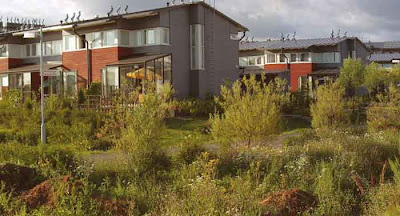Länsisatama - West Harbour: downtown by the sea, Landscape architecture competition - Press photos--City of Helsinki/City Planning Dep.
The Länsisatama (West Harbour) redevelopment project of the Helsinki City Planning Department is comprised of more than 200 ha of land on the southwest waterfront of the Finnish city. Like other planning projects in the area, this one has generated a lot of public interest. Indeed, the construction of a big new urban district from scratch is rare and raises the question: what is the city of the future?
[1]
The areas covered by Länsisatama project include:- the residential and office area of Ruoholahti (built in the 1990s)
- Jätkäsaari (used previously for cargo and passenger traffic)
- Munkkisaari (used as a dockyard, part of which will be freed for other uses in 2012)
In 2007, a local plan for a comprehensive solution to the Jätkäsaari area was in preparation. This year, during the next spring, the first detailed plan with the largest permitted building volume in Jätkäsaari will be handled in the Helsinki City Council. Jätkäsaari will house 15,000 residents and provide 6,000 jobs. The area was freed for construction when the cargo port was transferred to the new harbour in Vuosaari, at the end of 2008.
 Planning image of Vuosaari harbour--City of Helsinki/City Planning Dep.
Planning image of Vuosaari harbour--City of Helsinki/City Planning Dep.
Within the next two decades, the Länsisatama area will have been transformed into a waterfront city quarter with an estimated population of 22,000, which will enhance the appeal of central Helsinki and its services as a whole.
[2]
Jätkäsaari (2007 data)
Size: 100 ha
Parks: 19.8 ha (13 m2 per capita)
Residents: 14,500
Jobs: 6,000
Housing: 600,000 m2 gross floor area
Jobs and services: 364,000 m2 gross floor area
Parking spaces: 1 space per 150 m2 gross floor area
City investment: EUR 217 million
Construction start: 2008
Completion date: 2023
The Jätkäsaari planning goals
 Länsisatama - West Harbour: downtown by the sea, Landscape architecture competition - Press photos--City of Helsinki/City Planning Dep.
Länsisatama - West Harbour: downtown by the sea, Landscape architecture competition - Press photos--City of Helsinki/City Planning Dep.- Produce whole new attractive and ecologically sustainable city district, not just a sleepy suburb
- Meet the everyday needs of residents and workers
- Differing socio-economic groups live close to one another all over the city (town planning aims to encourage this assimilation).
- Construction of the new district is expected to help meet the need for all types of housing, thus easing the housing situation throughout Helsinki:
About one third of all the housing will be social housing i.e. moderately priced rental flats owned by the City and other non-profit landlords;
Another third will be price-regulated free-market housing and right-of-occupancy housing;
The remaining third will be privately funded housing.
- To take advantage of special features of the area (district is almost entirely surrounded by the sea and shipping)
- The passenger harbour on the east side of the area will remain in its present position, catering for some 3 million passengers per year travelling from Helsinki to Tallinn and St Petersburg and vice versa.
- The buildings have been designed so that the streets do not turn into wind tunnels.
- No residential buildings will be placed in the immediate vicinity of the passenger harbour, because of the noise, bustle and pollution caused by shipping.
- A beach will be created on a sheltered cove in the area.
- Mobility management - New Mobility Culture: non-dependence of private cars in daily traffic
- Available good alternative modes of transport : trams, service bus lines, car share vehicles, taxis, bikes.
- Cycle paths to serve those living and working in every part of the district.
- High quality pedestrian environment.
- Up to three tram lines.
- Helsinki Metro already runs close to the northern edge of the area.
- Very few streets allowing vehicular access.
- Every residential street will be a cul-de-sac.
- Minimizing motorized traffic will also apply to waste management (garbage removal underground): sorted household waste will go straight into a pneumatic conveyance system leading to a central underground collection point.
- Car-free lifestyle: return to the traditional practice of having ground-floor shops in a continuous line along the streets.
- Municipal services be located within walking distance of users' homes.
"We are putting up a whole new city district, not just a suburb. Our starting points are that life there must be ecologically sound and pleasant, and it must meet the everyday needs of residents and those who work there. Social well-being, mobility management and the special features of the area are also important factors,"
"We are realistic enough to know that many Jätkäsaari residents will want their own wheels, but our idea is that local services and routes will be planned so that a car will not be needed for local access. Multi-storey car parks are planned for residents to keep parked cars from clogging up the streets", said, in 2007, the Project Leader Matti Kaijansinkko, the architect in charge of planning Jätkäsaari. [2]
Architecture

Länsisatama - West Harbour: downtown by the sea, Landscape architecture competition - Press photos--City of Helsinki/City Planning Dep.
Another feature that Kaijansinkko was proud of is the green belt winding through the area, reminiscent of Manhattan's Central Park. The green belt is expected to achieve great popularity and importance for the life of the whole district.
"The park has been designed to accommodate as many popular Finnish outdoor pursuits as possible: it will be possible to ski and skate there, to cycle, to play games and to enjoy a picnic. There will also be a sledging hill for children." [1]
Urban Development
 InfoCentre Korona, the main building of Viikki green university campus district--City of Helsinki/City Planning Dep.
InfoCentre Korona, the main building of Viikki green university campus district--City of Helsinki/City Planning Dep.
Urban housing challenges in Finland are relatively new. However, rapid development in recent years have spurred the movement of people into growth centres and increased the demand for housing.
Outside growth centres, part of the housing stock is vacant as the population is declining. A current issue is how to maintain a unified community structure, especially in cities such as Helsinki where high house prices make it difficult to attract people working in the service sectors.
Therefore, in the next decades urban investments are needed in the following areas:
- Regenerating urban harbour areas in Helsinki
- Transport infrastructure in the metropolitan region
- Housing development
- Housing repairs
A record number of new student housing in Helsinki metropolitan area
 Eco-Viikki is a housing area but also a noteworthy and internationally renowned experimental project--City of Helsinki/City Planning Dep.
Eco-Viikki is a housing area but also a noteworthy and internationally renowned experimental project--City of Helsinki/City Planning Dep.
Second
YLE, the official site of Finland's national broadcasting company, in three years the Metropolitan area will rise to a record number of new student housing.
HOAS (Foundation for Student Housing in the Helsinki Region), responsible for the construction, plans to build a total of almost 900 new homes. In total, HOAS rents out 8,200 apartments to 17,000 tenants. The average annual construction volume will almost double. The normal annual rate has been 150-200 new homes. New estate will rise, mainly in Helsinki and Espoo.
HOAS was established by 16 student unions and student bodies in 1969 to help relieve the shortage of student housing within the Helsinki metropolitan area. HOAS student accommodation can be applied for by anyone undertaking full-time studies in a secondary level educational institution or university, and part of HOAS’s accommodation is reserved for international exchange students and researchers.
According to Heikki Valkjärvi, CEO of HOAS, the current economic climate is favourable to these plans: “Construction costs have come down, so we are trying to launch as many projects as possible”, Valkjärvi recently said to YLE.
The next few years, the major projects will rise in Viikki, Jätkäsaari, Kalasatama and Matinkylä Matinkylä district of Espoo. In addition, HOAS will also accelerate housing renovations.The Viikki project will launch a construction boom, which is larger than any other HOAS project has been for many years.
”Because of the new Aalto University, the focus on construction is likely to be in the west in the future”, Valkjärvi told to
HS.
 Kalasatama will be planned for 18 000 residents and 10 000 jobs--City of Helsinki/City Planning Dep.
Kalasatama will be planned for 18 000 residents and 10 000 jobs--City of Helsinki/City Planning Dep.
The chronic shortage of student housing continues in Helsinki, and the queues for housing at the HOAS have been increasing year after year. With the gradual increase in rents, most students are unable to compete in the unregulated rentals market in the
Greater Helsinki. In comparison, the Foundation charges EUR 220 for a small 18 m2 room with the basic amenities in a former old people’s home in Helsinki’s Ruskeasuo district, while a bedsitter on the open market would easily cost EUR 600 to 700.
The number of applicants doubled over three years - in August 2005, it was 3,300, while in the autumn of 2008, the figure was 6,200, setting a record in the 30-year history of HOAS.
References:
[1] Salla Korpela, Jätkäsaari – city life for the new millennium?, virtual.finland.fi, Ulkoasiainministeriö, September 2007
[2] City of Helsinki/City Planning Department,
Länsisatama - West Harbour: downtown by the sea,
www.hel.fi , 15.08.2008
Related articles:
City of the future is for people, not cars 11.10.2007









































